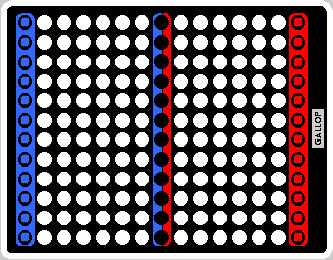Gallop
Luck and strategy for two players
Goal:
To be the first player to get 5 playing pieces into the opponent's Home Row.
Start:
Set up each player's 12 pieces on the 12 spaces of the matching-color Home Row as shown above.
Play:
On each turn, players roll the two dice and move any two of their pieces: one piece the number of spaces indicated by one die, and a different piece the number of spaces on the other die.
You do not receive an extra turn for rolling a double.
Movement of any piece in its own Home Territory or on the Center Bar may be forward, diagonally forward, or sideways — but in only one of these directions on a move. However, you may move one of your pieces in one direction and your other piece in a different direction on the same turn.
To enter the opponent's Home Territory, a player's piece must first land
on a Center Bar space by an exact count on the die.
Once a player's piece is in the opponent's Home Territory, it can move
forward, diagonally forward, sideways, backward or diagonally backward,
but again in only one of these directions on its move. That piece cannot
cross back into its own Home Territory, though it may land back on the Center Bar.
A player's piece may move through spaces occupied by other pieces, and all
such spaces are counted.
A player's piece may not land in a space occupied by a piece of its own
color.
A player's piece may land, with an exact count of the die roll, on a space occupied by an opponent piece, which is thereby captured and removed permanently from the board. A piece may capture in any direction it may legally move.
Pieces in either Home Row cannot be captured. Nor can they move within either Home Row. A piece once arrived in its target row is not moved again.
Capturing is not mandatory, even when it is possible to do so.
Winning:
The first player to get five pieces into the opponent's Home Row wins.
A player with fewer than 5 pieces left on the board cannot win; but by capturing at least 8 of the opponent's pieces, it can bring the game to a draw.
GALLOP was invented by Christopher Clark

Queen's Four
Pure strategy for 2 players
Start:
Each player rolls a die. The player with the higher number chooses a game color and is the first to start the game. On the Center Bar of the GALLOP gameboard, set up 6 playing pieces of each player in alternating pairs, like this:
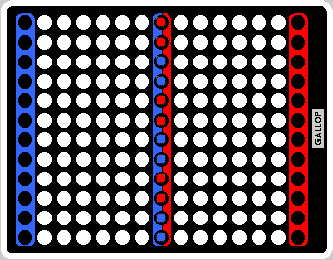
Goal:
To be the first player to get four pieces in a straight line in any four adjoining spaces (including the Center Bar and either Home Row), in any direction — horizontally, vertically or diagonally.
Play:
Players take turns moving any one of their playing pieces like a Chess Queen — any distance in an open row in any direction. Moves may be horizontal, vertical, or diagonal. The dice are not used in this game.
There is no capturing, and pieces may not land on nor move across occupied spaces.
You'll need careful blocking strategies for this game.
QUEEN'S FOUR is the invention of Christopher Clark,
with suggestions by Kate Jones.

Leap Over
Jumping strategy for 2 players
Start:
Set up the 12 pieces for each player in two rows of 6, at opposite ends of one half of the GALLOP gameboard (one Home Territory), like this:
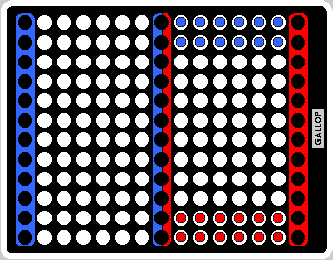
Play:
Take turns moving any one piece at a time, using short straight leaps only (straight over another piece to the empty space immediately on the other side of it). Leaps may be horizontal, vertical or diagonal, forward, sideways or backwards, or any combination of these when multiple leaps are taken. Leaps may go
over either player's pieces. There is no capturing. Each move must be a leap;
no single "steps" are allowed. Stay within the 6x12 field. The Center Bar spaces and home row spaces are not used.
Goal:
To be the first player to move all 12 pieces into the opponent's starting spaces.
Hint: Avoid stragglers, keep pieces moving in close clusters.
LEAP OVER was invented by Kate ]ones

Skwhere
Square-forming capturing strategy for 2 players
Start:
Set the 12 pieces for each player on the players' Home Row spaces as a holding area. Decide who goes first, and choose one of the two halves (Home Territory) of the gameboard as the field of play. (The Center Bar, Home Rows, and the other Home Territory are not used for this game.)
Goal:
To form squares and capture pieces. The winner is the player who still has pieces left to play when the other player has none.
Play:
First player places a piece in any space of the 6xl2 field. Thereafter, take turns placing one piece at a time on any empty space so that the new piece is directly next to a piece already on the board — either horizontally, vertically, or diagonally.
You form a square when you complete its four corners with four pieces of your color. The square can be any size, and at any angle on the board. Here are some examples:
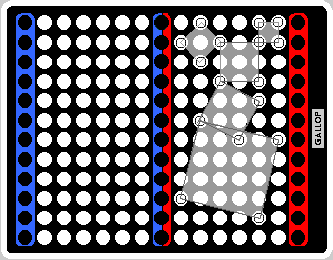
When you complete a square by placing its fourth corner of your color, you
get to remove all the pieces inside it (see shaded areas). Any piece within that area becomes the property of the player who formed that square. Any pieces of your own color that you get back this way can be reused on a future turn. The opponent's pieces are captured and held for possible recovery or trade. Park all captured and regained pieces on your Home Row.
- Recovery: When a player forms a square but there are no pieces inside it to be taken, either because the square formed is a solid 2x2 square or because the space between the four corners is empty, the player can recover one captured piece from the opponent's hold. If the opponent is not holding any captive pieces, the player gets another turn to place a piece.
- Trade: When one player has just placed the last available piece but still holds some opponent pieces captive, a trade or exchange of captured pieces takes place. The exchange rate is 1 for 1. The player with more captives thus can get back all pieces and hold the remaining captives for future trade.
- Moving: When a player has no more captives to trade nor pieces left on the Home Row, but has at least four pieces still remaining in the field, that player may move any one of those pieces to any other space in the field (adjacent to some other piece, of course).
When such a move completes a square and either frees a captive from the
opponent's hold or acquires a new supply of pieces or captives from the field, the player will again place such available pieces on future turns rather than moving.
Winning:
When one player has no more pieces to place, and has no more captives to trade, and has fewer than 4 pieces remaining in the field, the game is over. The player with pieces still left to play is the winner.
Special cases
- When a square is formed but the player whose turn it is does not notice it
and does not claim the captured pieces, the pieces stay on the board and neither player gets them. They cannot be claimed after a turn is over.
- When more than one square is formed with the same piece, the player gets the captures from both of them. Where two or more squares are formed that do not enclose any pieces, the player recovers a captured piece for each such square.
- Provided that they are being placed adjacent to some other piece in the field, pieces may safely be replaced in spaces inside previously formed squares. Only the actual move that creates a square will capture.
- Because forming a square captures all its interior pieces, there will be
isolated or non-adjacent pieces left in the field. That's okay. It is only
a new piece that must go next to one already on the board.
SKWHERE was contributed by Dale Walton,
adapted by Kate Jones

Sidle
Strategy with stick dice for 2 players
Start:
Set up the 12 pieces for each player as for Gallop, on the 12 spaces of the Home Row of their own color.
Goal:
To be the first player to have 5 pieces in the opponent's Home Row.
Play:
On each turn, roll the 4 stick dice, calculate the number they represent, and move any one of your pieces that many spaces straight forward or straight backward only. Pieces may not move through or jump over pieces of either color. There are no diagonal moves.
When the piece completes its move, it then makes a free sideways move ("Sidle") any distance left or right but never through another piece. If the move ends on the Center Bar, then any other piece of the same color may Sidle instead.
Capturing:
When a move ends on an opponent piece, that piece is captured and removed from the game. Only forward or backward moves may capture; Sidle moves do not. Pieces making a capture get no Sidle move on that turn. A Center Bar capture does not get a Sidle move of another piece. The player who makes a capture gets another turn. Captures may be made anywhere on the board except in the two Home Rows.
Home Row action:
A piece needs an exact roll to enter the opponent's Home Row. Once it arrives, it may Sidle within the Home Row. Unlike in Gallop, arrived pieces may later move back out of the Home Row. They may move back as far as into their original starting row and Sidle there. However, you win only when you have 5 of your pieces in the opponent's Home Row at the same time.
Reading the Dice:
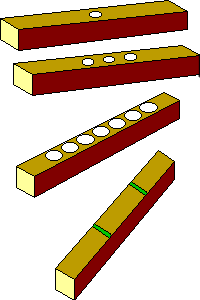 The four sticks have pips of 1, 3, 7 and 2 bars on opposite faces, with blanks on the other two faces. Roll all the sticks at once and add up the number of pips that land on top. If the bars are showing, double the lowest number. If only the bars are showing, roll again. If all 4 sticks come up blank, you get a 0 for that turn. The sticks can roll anywhere from 0 to 14. You must move the full count of what you rolled, if possible, or not move on that turn. The four sticks have pips of 1, 3, 7 and 2 bars on opposite faces, with blanks on the other two faces. Roll all the sticks at once and add up the number of pips that land on top. If the bars are showing, double the lowest number. If only the bars are showing, roll again. If all 4 sticks come up blank, you get a 0 for that turn. The sticks can roll anywhere from 0 to 14. You must move the full count of what you rolled, if possible, or not move on that turn.
SIDLE was invented by Christopher Clark

The Gallop instruction book also contains many fascinating solitaire challenges.
| 

